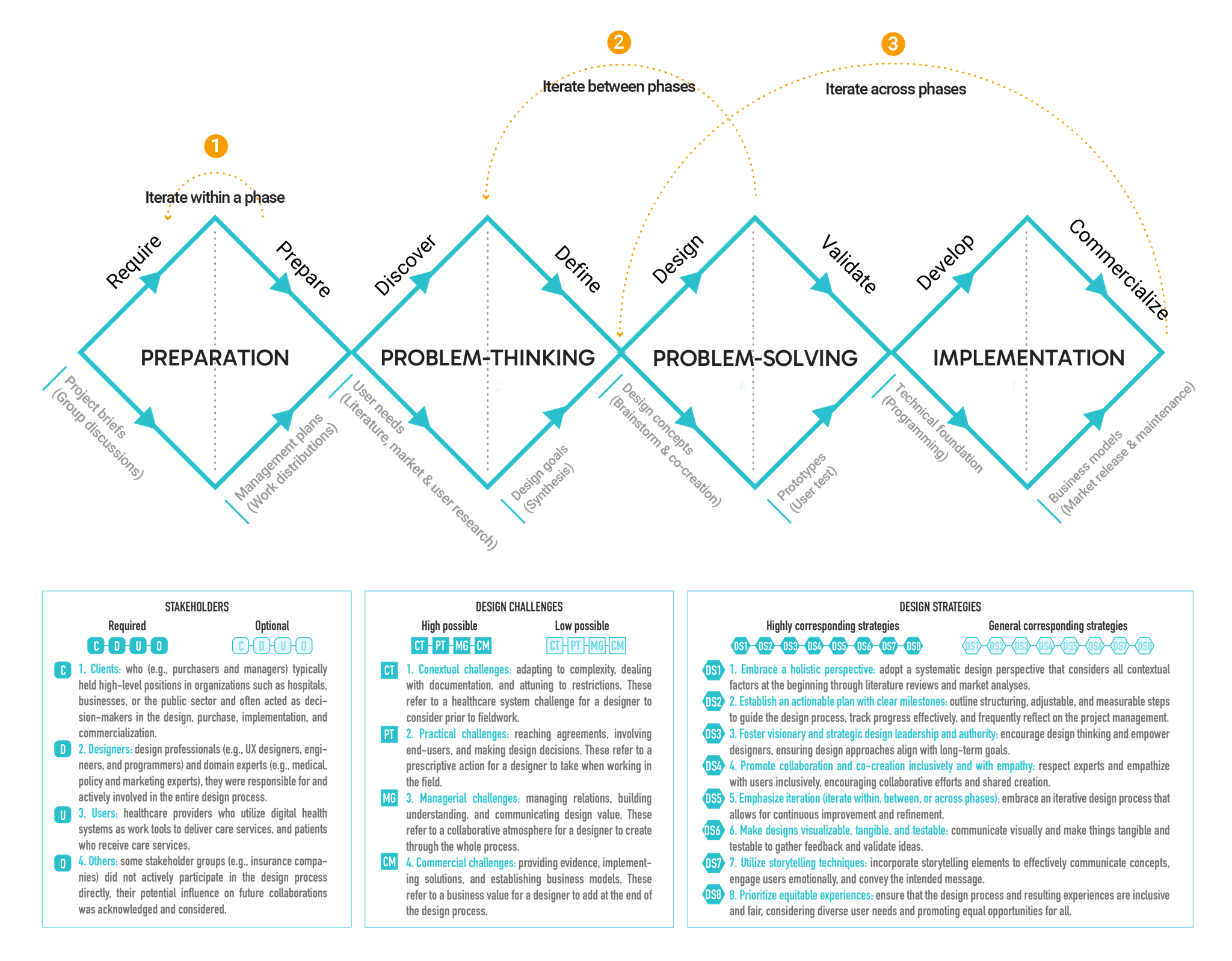Plan your digital health design project
This section can help you see the big picture and build design leadership.
*The information of this page is based on:
Wang, T., Giunti, G., Melles, M., & Goossens, R. (2022). Design-Relevant Factors Affecting the Patient Experience in Digital Health: Preliminary Results of an Umbrella Systematic Review. Studies in health technology and informatics, 290, 862–866. https://doi.org/10.3233/SHTI220202
Wang, T., Giunti, G., Melles, M., & Goossens, R. (2022). Digital patient experience: umbrella systematic review. Journal of medical Internet research, 24(8), e37952.
Process

Steps
1.1 Clarifying project requirements
Meet your clients and design team (if any) to discuss your design tasks and project requirements. Design tasks could be very specific or super broad:
Completing a specific design task
Addressing a daily problem
Improving the patient experience.
Project requirements need clarification early on:
Expected project duration, cost, and stakeholders
User, technical, legal, and business requirements
Risks, ethical, and technical constraints
Here is a task and requirement template.
1.2 Creating a project plan
A plan gives you and your stakeholders a comprehensive understanding of project complexity and provides you with a dialogue that breaks down divisions. To make your own project plan, start with:
Building your team.
Considering time management.
Distributing design tasks.
Determining methodology
Setting milestones and indicators.
You can use tools such as Miro, Notion, gantt chart to create your project plan.
Tips
Stakeholders
C
D
U
O
At this stage, you need to involve:
Clients: purchasers and managers, hospitals, businesses, or the public sector.
Designers: UX designers, engineers, programmers, medical, policy, and marketing experts.
Other optional stakeholders…
Users: healthcare providers who utilize digital health systems as work tools to deliver care services, and patients who receive care services.
Others: some stakeholder groups (e.g., insurance companies) did not actively participate in the design process directly, their potential influence on future collaborations was acknowledged and considered.
Design Challenges
CT
PT
MG
CM
At this stage, you might meet challenges…
Contextual Challenges refer to healthcare system challenges a designer should consider prior to fieldwork. Includes adapting to complexity, dealing with documentation, and attuning to restrictions.
Managerial Challenges refer to the collaborative atmosphere a designer should create throughout the whole design process. Includes managing relations, building understanding, and communicating design value.
Other potential challenges…
Practical Challenges: reaching agreements, involving end-users, and making design decisions. These refer to a prescriptive action for a designer to take when working in the field.
Commercial Challenges: providing evidence, implementing solutions, and establishing business models. These refer to a business value for a designer to add at the end of the design process.
Design strategies
DS1
DS2
DS3
DS4
DS5
DS6
DS7
DS8
You can address the above challenges by using…
DS1: Embrace a holistic perspective and system thinking through a literature review and market analysis.
DS2: Establish an actionable plan with clear milestones. Structured, adjustable, and measurable steps will help you track and reflect on your progress effectively.
DS3: Foster visionary and strategic design leadership and authority. Empower your team with design thinking and align your design approaches with long-term project goals.
DS4: Promote collaboration and co-creation inclusively and with empathy. Include your collaborators and stakeholders, listen to their stories, observe their behaviors, and uncover their needs.
DS6: Make visualizable, tangible, and testable designs. Communicating visually and making things tangible and testable can help you gather feedback and validate ideas.
DS7: Utilize storytelling techniques. Incorporate examples and metaphors to effectively convey a message to your target users and engage them emotionally.
Other potential strategies…
DS5: Emphasize iteration (iterate within a phase, between phases, or across phases). You can continuously improve and refine your design by embracing an iterative design process.
DS8: Prioritize equitable experiences. Have you heard about the Buckets Effect. Listening to different voices, balancing diverse needs, and providing a comparable experience for multiple stakeholders will help you reduce implementation obstacles.






